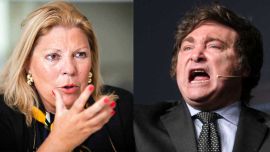Columbus Day today (marking the beginnings of the world’s first real process of continental interaction in 1492) is one candidate to mark the birth of globalisation which is the focal point of this series, especially where Argentina is concerned. While we await a precise identification of the next government – not only its party or coalition label but also its general thrust – today’s international body filling the vacuum of the current phoney war (or “drôle de guerre,” as the French call it) will be the International Labour Organisation (ILO), if only because of the way trade unions dominated the news at the end of last week. On that Thursday, the reunification of Argentina’s organised labour was solemnly announced in answer to the appeal of Frente de Todos presidential Alberto Fernández – even if the unity is more apparent than real within the CGT and CTA labour umbrellas, never mind between them, just as it is in the Frente de Todos coalition, without going into how the trade unions are increasingly being eclipsed by the picket movements – while the week closed with the Aerolíneas Argentinas pilot strike averted at the last minute by a histrionic intervention from Fernández.
Like pretty much all the international organisations we have covered until now, the ILO is a post-war creation but following a different conflict – World War I, not II, as part of the Treaty of Versailles in 1919. The ILO is thus marking its centenary this year as something of the dean of international organisations.
At that time the creation of the ILO was a reaction to Russia’s Bolshevik Revolution of 1917 just as surely as the League of Nations was to the bloodbath of World War I – a global fear from which Argentina was not immune with the “Semana Trágica” early in that same year of 1919, followed by the even worse massacres of “Patagonia Rebelde” two years later. The “Semana Trágica” was the bloody repression of a strike at the Talleres Vasena plant (manufacturing iron pillars and girders for the construction industry) eventually leaving at least 700 people dead – not all strikers since there was a parallel pogrom slaughtering several dozen Jews – while the “Patagonia Rebelde” ended in the mass execution of thousands of farm hands joining an anarchist-led strike on Santa Cruz sheep ranches.
Despite this unpromising context, Argentina was a founding member of the ILO in 1919 because the government repressing worker protest so brutally was also one of the most progressive in Argentine history, paradoxically enough – Argentina’s first presidency with universal manhood suffrage under the Radical Hipólito Yrigoyen (1916-22). As the strikes of 1919-1921 might indicate, Argentina already had a lively labour movement. While gauchos always showed a defiantly independent streak, trade unionism as such was imported from Europe along with the mass immigration. As in so many other countries, printers were the first to organise as from 1857 (a fully-fledged union 20 years later) while the first labour confederation was in 1890. But throughout the interwar period the workers’ movement was dominated by socialists and anarchists.
Argentina’s current relationship with the ILO needs to be viewed through the prism of over seven decades of Peronist trade unionism, while the opening of ILO offices here exactly half a century ago (in late 1969) is a key milestone. Precisely because of the strength of its trade unionism – the “spine” of the Peronist movement, according to its founder – Argentina has never been a top priority for the ILO, whose attention has been drawn far more by the historymaking struggles of workers in Polish shipyards and South African mines. The usual perception was that Argentine trade unions were very good at looking after themselves, with no need for external aid, while military dictatorships never lasted long enough to change that perception.
The permanent relationship thus tends to be bureaucratic – although not inactive with 81 ILO conventions covering a wide range of social and labour issues ratified over the years – with the main news splashes coming from the International Labour Conference held annually in Geneva in midyear (actually with slightly greater frequency since there have been 108 sessions in the ILO’s century of existence). At this tripartite event Argentina invariably stands out in quantitative terms at least with threedigit delegations while other countries settle for a few dozen representatives – last year’s 181-strong contingent was the most numerous of any country. There tends to be a fixed cast for this traditional ritual with Gerardo Martínez of the UOCRA construction workers and Daniel Funes de Rioja from the food industry representing labour and management respectively for as long as anyone can remember, alongside numerous Peronist politicians and trade union leaders (neither the CGT nor the Labour Ministry have been generally to blame for the high numbers).
Although predating the United Nations, the ILO joined the UN as its first specialised agency in 1946 and today contains 186 of the 193 UN members. Each member nation has four delegates (two from the government with one each for employers and employees). The headquarters have been in Geneva since 1920 apart from a 1940-1948 period in Montreal following a safety move during World War II with a current staff of around 2,700 officials (including some 40 offices around the world), tirelessly compiling comprehensive labour statistics among other tasks. In 1969 (the same year as the opening of the Buenos Aires office) the ILO was awarded the Nobel Peace Prize. Until then the ILO had been an unambiguously centre-left voice on the world stage, tracing directly back to the origins of the idea of an international labour association in the Second International, but shortly afterwards two developments prompted a shift to the right – the temporary withdrawal of the United States (1975-1980) and the defence of Poland’s Solidarnosc union movement against Soviet Communism, which became a crusade for the ILO pushing it towards the Washington Consensus.
There have been 10 directors-general in the ILO’s century, all of them from an English- or French-speaking country except Chile’s Juan Somavia (1999-2012), the only Latin American – David Morse of the US (1948-1970) and Frenchman Francis Blanchard (1974-1989) have been the most durable. Cambridge-educated Liverpudlian Guy Ryder has been in charge since 2012, confronting such challenges of the 21st century as the growing obsolescence of trade union structures in the digital economy.
A growing obsolescence which does not prevent numerous
economists and the International Monetary Fund from stressing the urgency of labour reform to cut free of the Argentine
cost shackling economic take-off – how the next government
responds to these pressures may or may not be the occasion for
a further column on these issues. related news

One body, many fears: US immigration enforcement turns problem of scale into personal violence

Trump reveals Macron text in pre-Davos blitz on major US allies

Milei’s relentless chainsaw – the great campaign promise he kept

Milei decree reshapes Argentina’s intelligence apparatus, rekindling overreach fears

















Comments